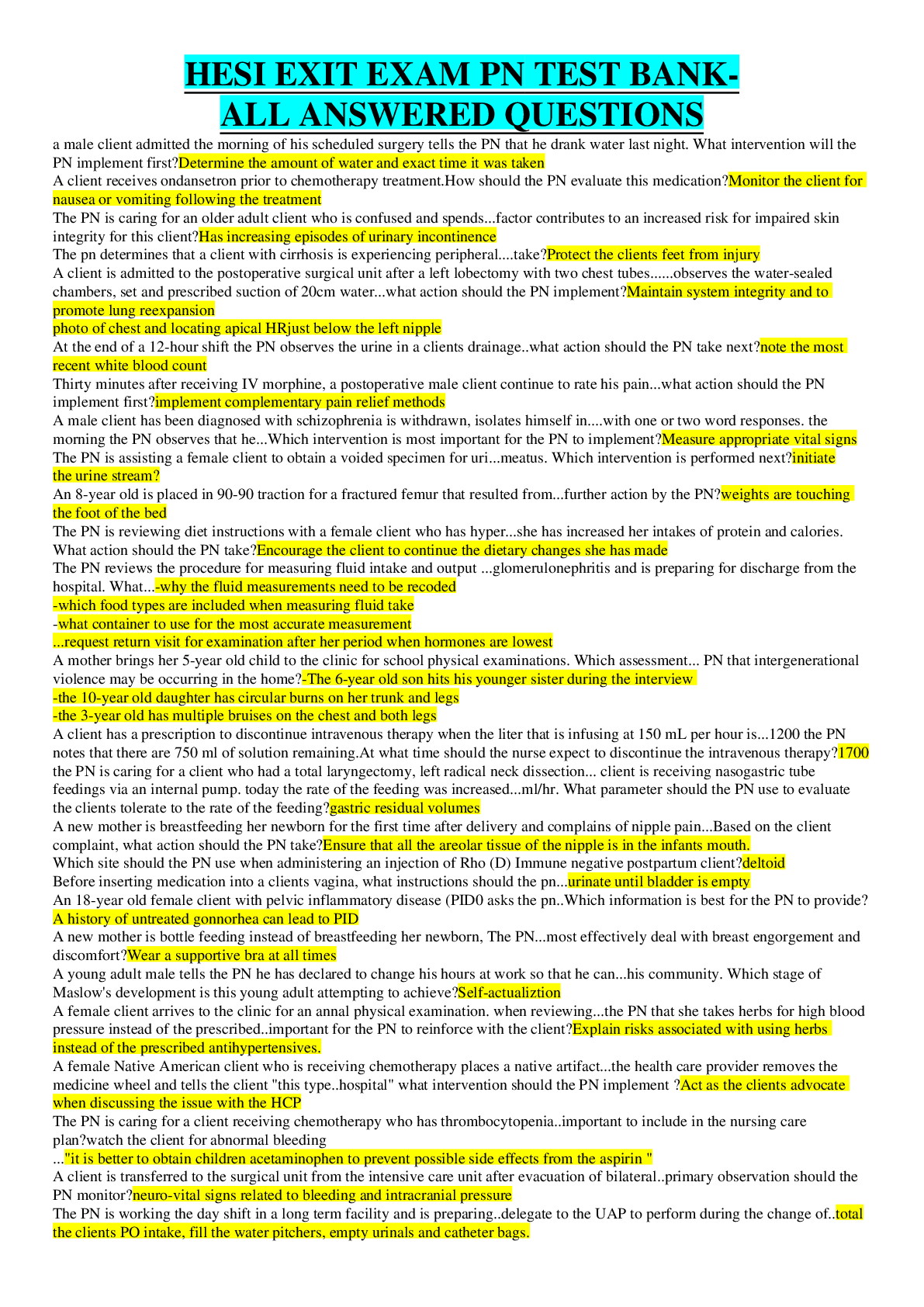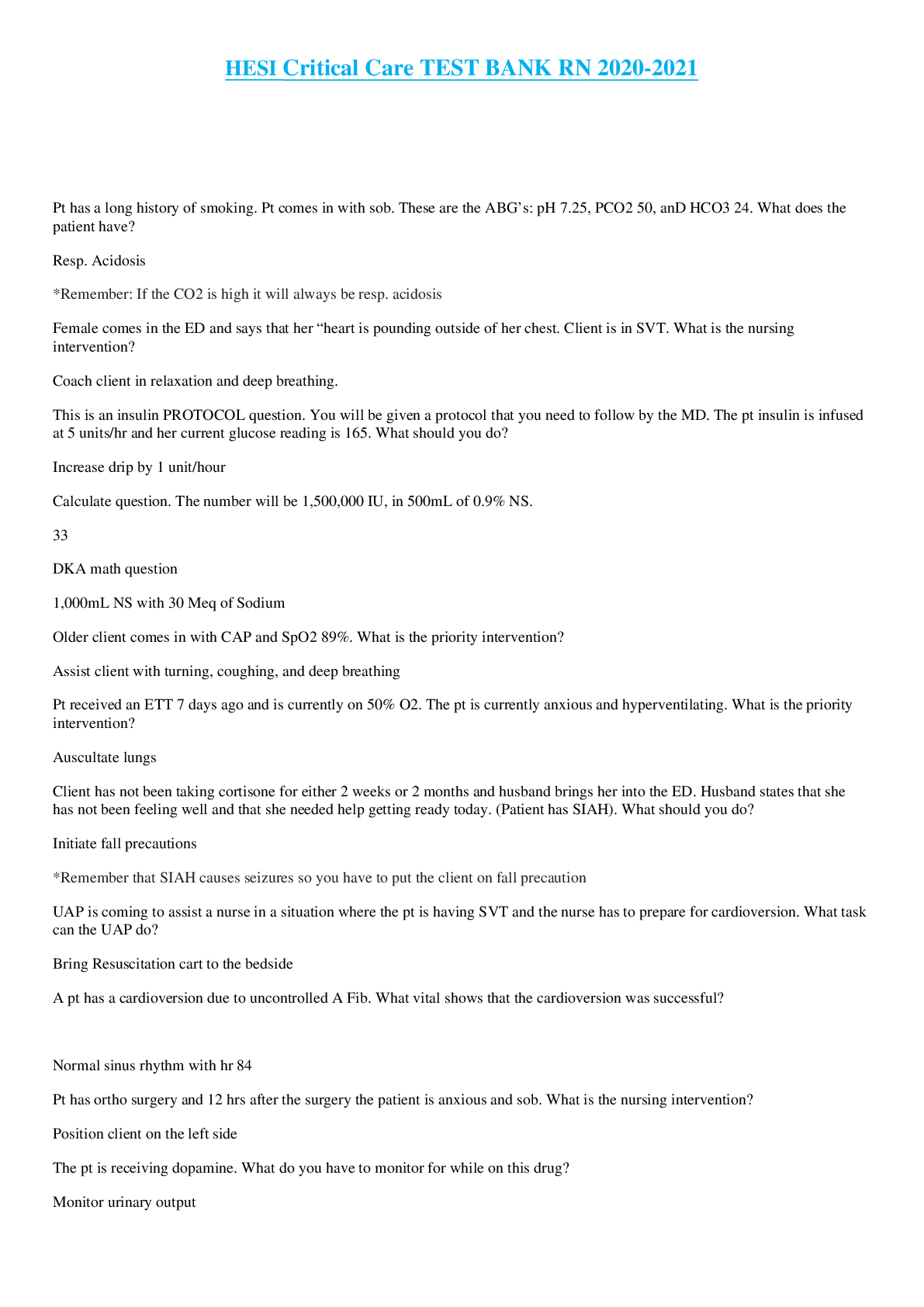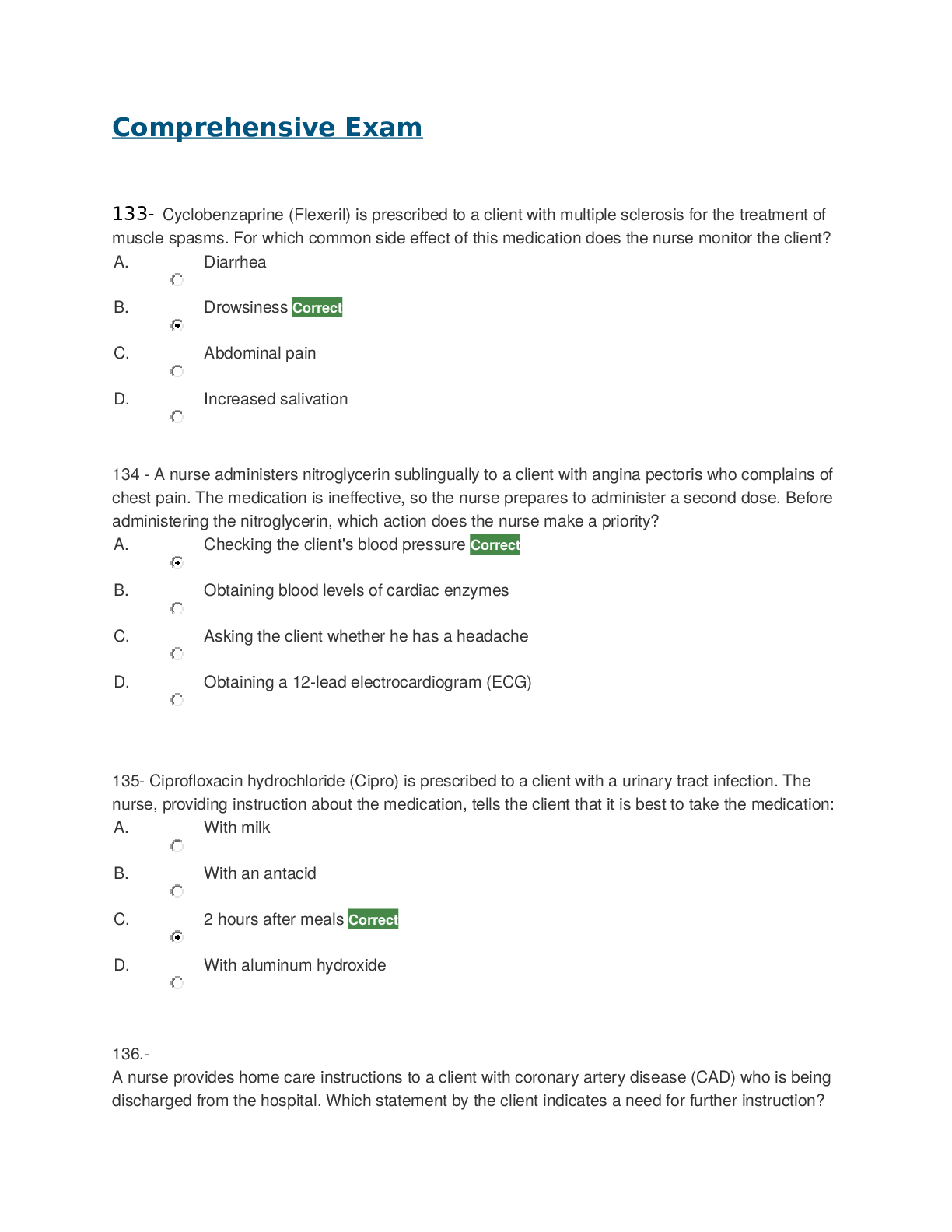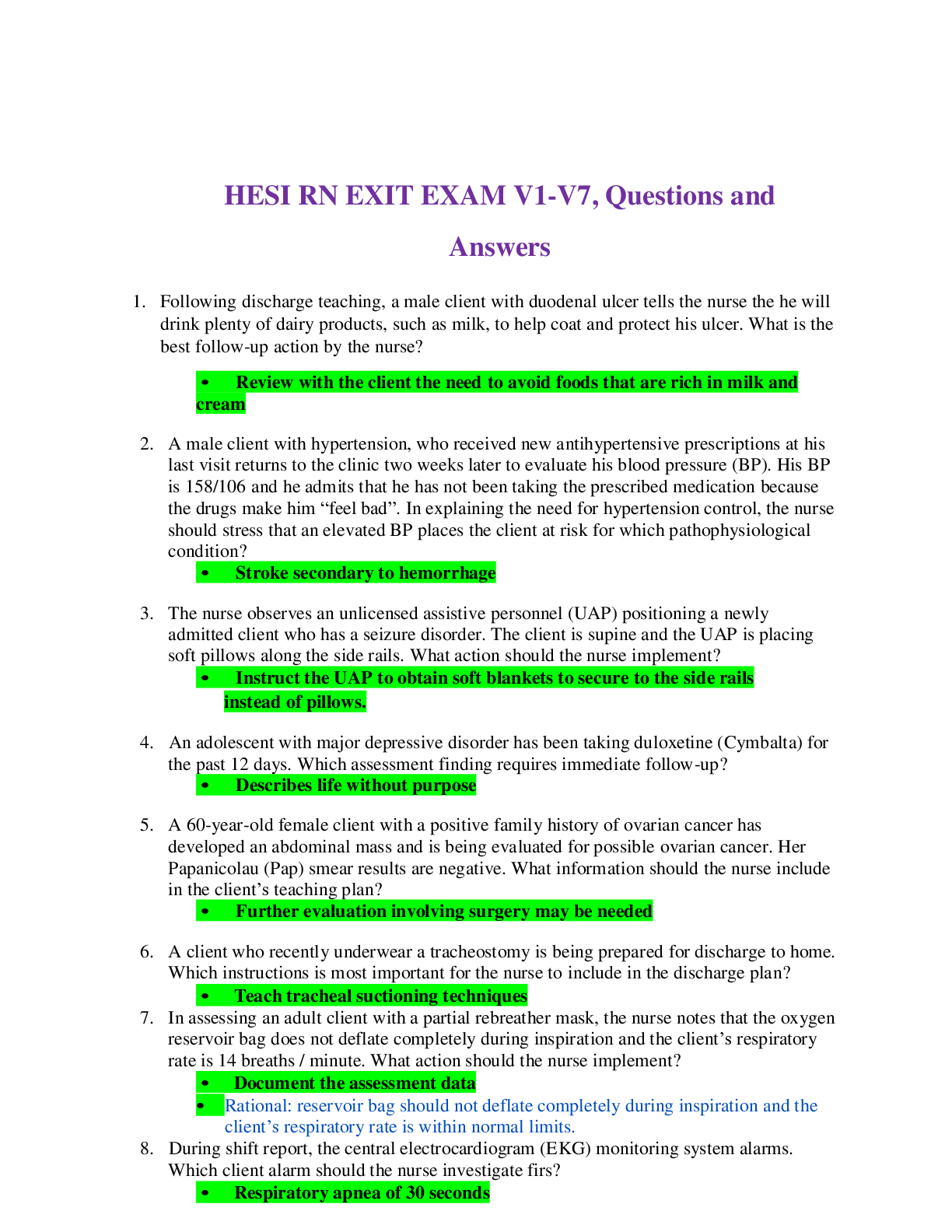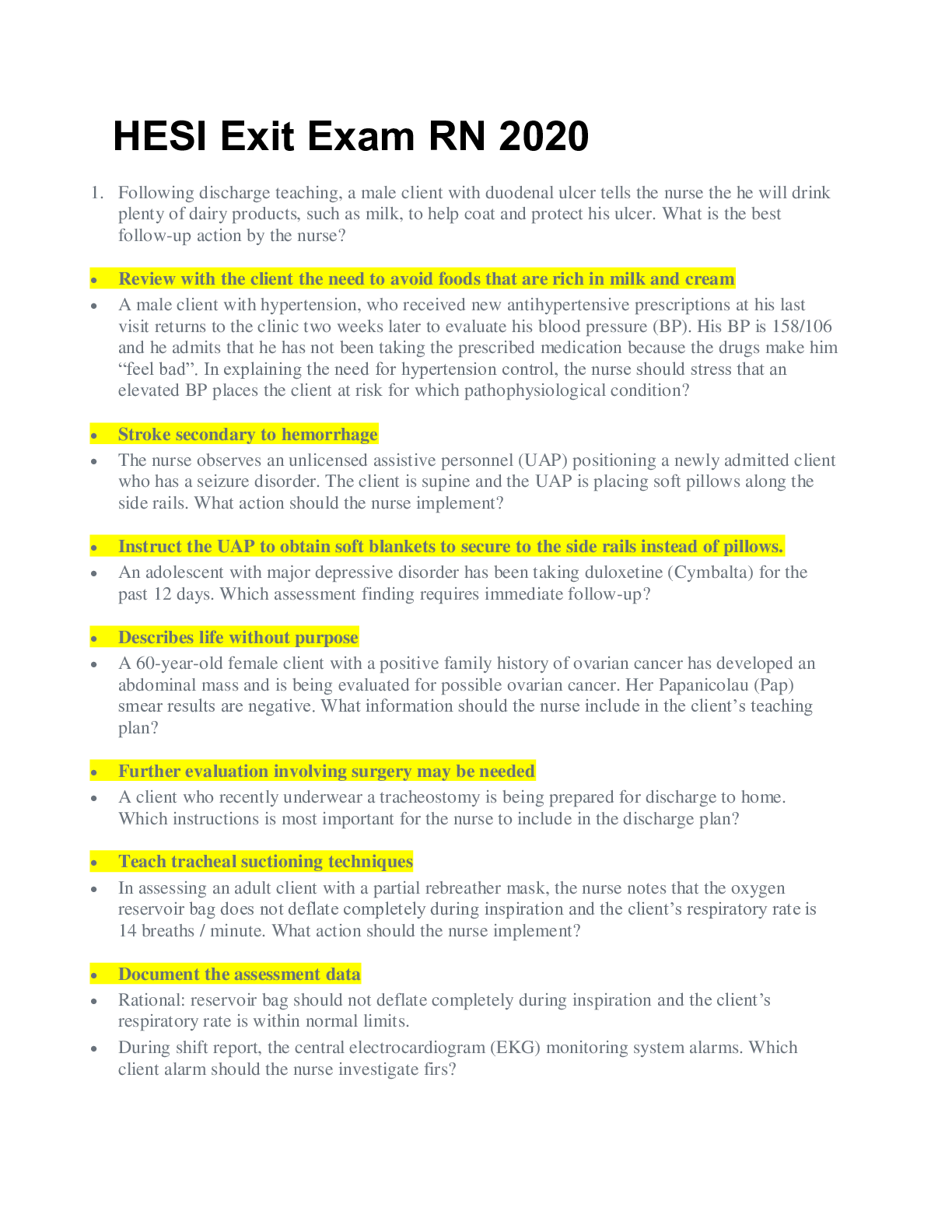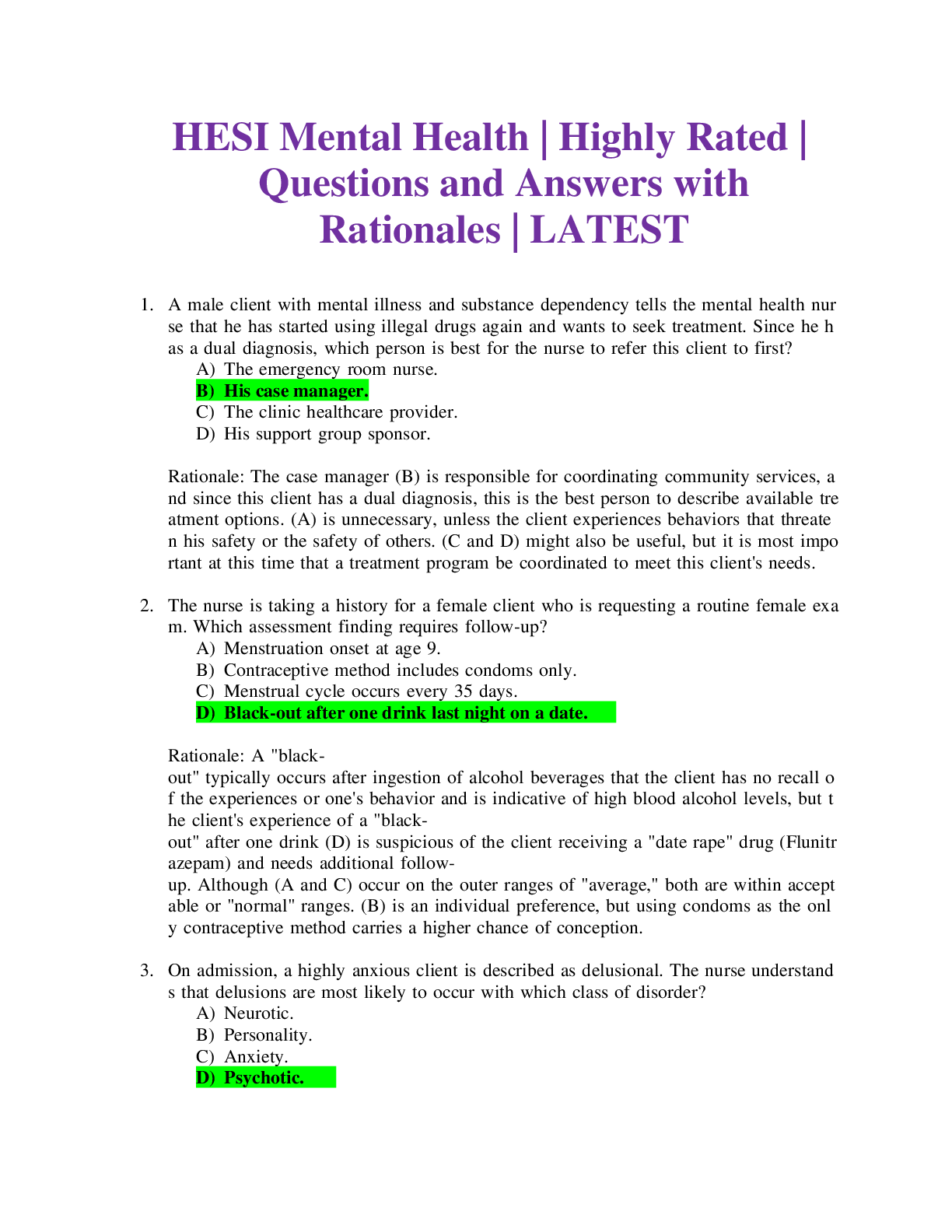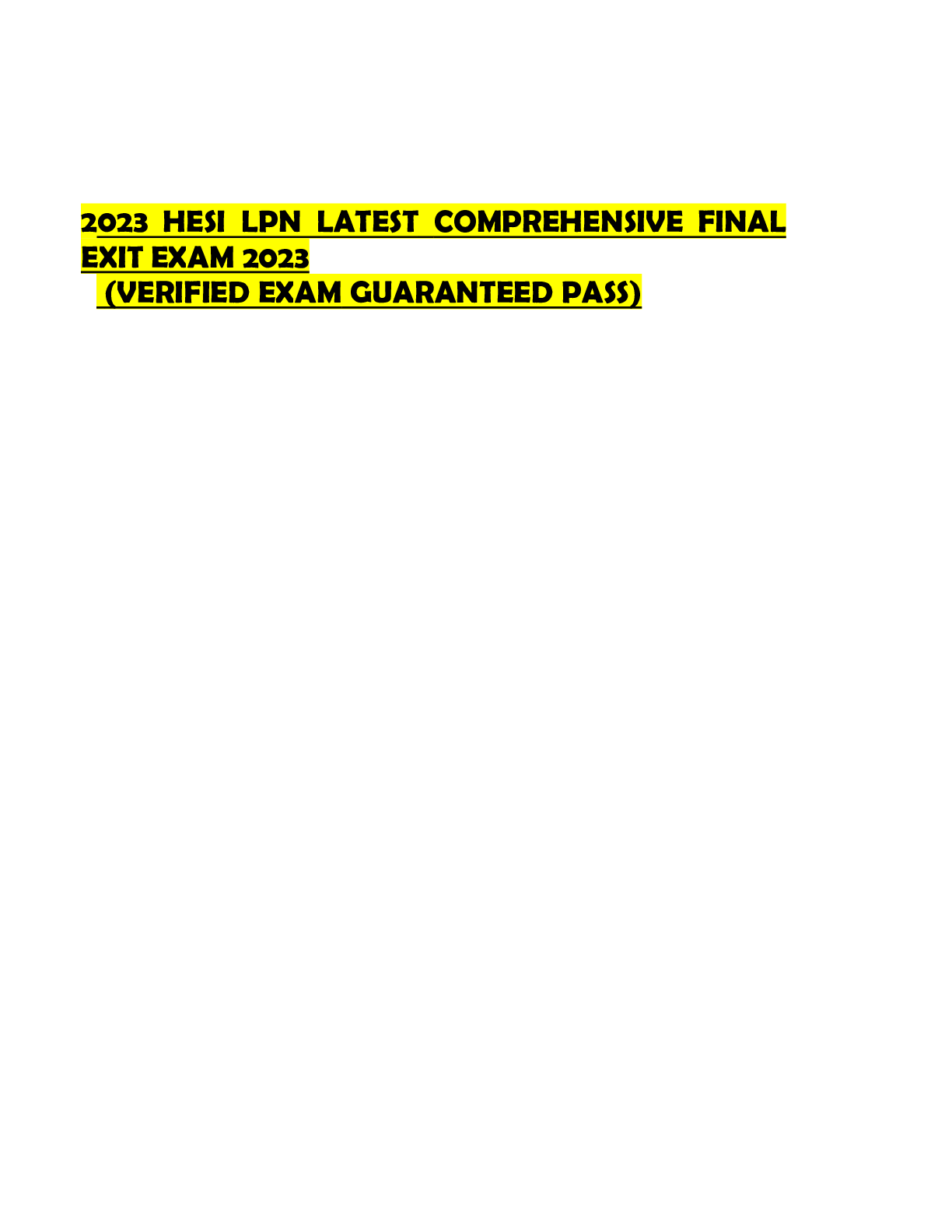*NURSING > HESI > HESI 2019 Version 2 /Exam (elaborations) NURSING REVIEWHESI 2019 V2 (NURSING REVIEWHESI 2019 V2) (All)
HESI 2019 Version 2 /Exam (elaborations) NURSING REVIEWHESI 2019 V2 (NURSING REVIEWHESI 2019 V2)
Document Content and Description Below
HESI 2019 Version 2 Yellow Highlight = Unverified answer 1. The school nurse is preparing a presentation for a elementary school teachers to inform teachers to inform them about when a child should be... referred to the school clinic for further follow-up. The teachers should be instructed to report which situations to the school nurse? (Select all that apply) A. Refuses to complete written homework assignments. B. Thirst and frequent requests for bathroom breaks. C. Bruises on both knees after the weekend. D. Sunburn with blisters on the face, arms, and hands. E. Shaking that changes the child’s hand writing. ANS: B D E 2. When preparing a client for discharge from the hospital following a cystectomy and a urinary diversion to treat bladder cancer, which instruction is most important for the nurse to include in the client’s discharge teaching plan? A. Report any signs of cloudy urine output. B. Frequent empty bladder to avoid distention. C. Follow instructions for self-care toileting. D. Seek counselling for body image. ANS: A 3. A client with renal lithiasis is receiving morphine sulfate every four hours for pain and renal colic. Which assessment finding should prompt the nurse to administer a PRN dose of naloxone? A. Unresponsive to verbal or tactile stimuli. B. Respiratory rate of 12 breath/minute. C. Statements about visual hallucinations. D. Complaints of increasing flank pain. ANS: A 4. The mother of a 7-month-old brings the infant to the clinic because the skin in the diaper area is excoriated and red, but there are no blisters or bleeding. The mother reports no evidence of watery stools. Which nursing intervention should the nurse implement? A. Instruct the mother to change the child’s diaper more often. B. Encourage the mother to apply lotion with each diaper change. C. Ask the mother to decrease the infant’s intake of fruits for 24 hours. D. Tell the mother to cleanse with soap and water at each diaper change. ANS: A 5. The nurse is having difficulty palpating a client’s posterior tibial pulse while the client is lying in a supine position? A. Extend the client’s arm fully while supporting the elbow and attempt to repalpate. B. Apply less pressure when palpating over the middle of the dorsum of the foot. C. Use an ultrasound stethoscope place behind and below the medial bone. D. Help the client to a prone position with the knee slightly flexed and palpate again. ANS: D 6. The nurse implements a tertiary prevention program for type 2 diabetes in a rural health clinic. Which outcome indicates that the program was effective? A. Average client scores improved on specific risk factor knowledge tests. B. Only 30% of clients did not attend self-management education sessions. C. More that 50% of at-risk clients were diagnosed early in the disease process. D. Client who developed disease complications promptly received rehabilitation. ANS: D 7. A client is recovering in the critical care unit following a cardiac catheterization. IV nitroglycerin and heparin are infusing. The client is sedated but responds to verbal instructions. After changing positions, the client complains of pain at the right groin insertion site. What action should the nurse implement? A. Stimulate the client to take deep breaths. B. Evaluate the integrity of the IV insertion site. C. Assess distal lower extremity capillary refill. D. Check femoral site for hematoma formation. ANS: B 8. A 7-year old is admitted to the hospital with persistent vomiting, and nasogastric tube attached to low intermittent suction is applied. Which finding is most important for the nurse to report to the healthcare provider? A. Shift intake of 640 ml IV fluids plus 30 ml PO ice chips. B. Serum pH of 7.45 C. Serum potassium of 3.0 mg/dl. D. Gastric output of 100 ml in the last 8 hours. ANS: C 9. A morbidly obese client is scheduled for gastric bypass surgery. The client completes the required preoperative nutritional counselling and signs the operative permit. To promote effective discharge planning, which intervention is most important for the nurse to implement? A. Discuss small, low fat, low sugar meal preparation techniques. B. Advise the client to arrange for dietary counselling after discharged. C. Encourage the client to keep a daily diary for two weeks. D. Suggest that the client’s spouse do the family grocery shopping. ANS: A 10.The nurse is admitting a client from the post anesthesia unit to the postoperative surgical care unit. Which prescription should the nurse implement first? A. Cefazolin 1-gram IVPB q6 hours. B. Complete blood cell count (CBC) in AM. C. Straight catherization if unable to void. D. Advance from clear liquid as tolerated. ANS: 11. Which needle should the nurse use to administer intravenous fluids (IV) via a client’s implanted port? ANS: C 12. An older client is referred to a rehabilitation facility following a cerebrovascular accident (CVA). The client is aphasic with left-side paresis and is having difficulty swallowing. Which intervention is most important for the nurse to include in the client’s plan of care? A. Use pictures and gestures to communicate. B. Arrange for daily home care assistance. C. Facilitate a consultation for speech therapy. D. Initiate passive range of motion exercises. ANS: C 13. A client has had several episodes of clear, watery diarrhea that started yesterday. What action should the nurse implement? A. Assess the client for the presence of hemorrhoids. B. Administer a prescribed PRN antiemetic. C. Check the client’s hemoglobin level. D. Review the client’s current list of medications ANS: D 14. A mother runs into the emergency department with a toddler in her arms and tells the nurse that her child got into some cleaning products. The child smells of chemicals on hands, face, and on the front of the child's clothes. After ensuring the airway is patent, what action should the nurse implement first? A. Call poison control emergency number. B. Determine type of chemical exposure. C. Obtain equipment for gastric lavage. D. Assess child for altered sensorium. ANS: D 15. When should the nurse conduct an Allen’s test? A. Prior to attempting a cardiac output calculation. B. When pulmonary artery pressures are obtained. C. Just before arterial blood gasses are drawn peripherally. D. To assess for presence of deep vein thrombus in the leg. ANS: C 16. A nurse with 10 years experience working in the emergency room is reassigned to the perinatal unit to work an 8 hour shift. Which client is best to assign to this nurse? A. A mother with an infected episiotomy B. A client who is leaking clear fluid. C. A client at 28-weeks gestation in pre-term labor. D. A mother who just delivered a 9-pound baby. ANS: A 17. A 300 ml unit of packed red blood cells is prescribed for a client with heart failure (HF) who has 3+ pitting edema, shortness of breath with any activity, and activity, and crackles in both lung bases. What rate should the nurse administer the blood? A. 150 ml/hour. B. 75 ml/hour. C. 300 ml/hour. D. 50 ml/hour. ANS: A 18. The nurse enters the room of a client with Parkinson’s disease who is taking carbidopa levodopa. The client is arising slowly from the chair while the unlicensed assistive personnel (UAP) stands next to the chair. What action should the nurse take? A. Tell the UAP to assist the client in moving more quickly. B. Offer PRN analgesic to reduce painful movement. C. Affirm that the client should arise slowly from the chair. D. Demonstrate how to help the client move more efficiently. ANS: C 19. Which assessment is more important for the nurse to include in the daily plan of care for a client with a burned extremity? A. Range of Motion B. Distal pulse intensity C. Extremity sensation D. Presence of exudate ANS: B 20. Client is receiving continuous ambulatory peritoneal dialysis since the arteriovenous (AV) graft in the right arm is no longer available for use for hemodialysis. The client has lost weight, has increasing peripheral edema, and has a serum albumin level of 1.5 g/dl (15 g/L). Which intervention is the priority for the nurse to implement? A. Instruct the client to continue to follow the prescribed rigid fluid restriction amount. B. Evaluate patency of the AV graft for resumption of hemodialysis. C. Ensure the client receives frequent small meals containing complete proteins. D. Recommend the use of support stocking to enhance venous return. ANS: C 21. An older adult client with systemic inflammatory response syndrome (SIRS) has a temperature of 101.8 F (38.8 C), heart rate of 110 beats/minute, and a respiratory rate of 24 breaths/minute. Which additional finding is most important to report to the healthcare provider? A. Capillary glucose reading of 110 mg/dl (6.1 mmol/L SI) B. Serum creatine of 2.0 mg/dl (176.8 micromol/L SI) C. Hemoglobin of 12. g/dl (120 g/dl SI) D. Blood pressure of 130/88 mm hg. ANS: B 22. The nurse completes auscultation of the thoracic region of an older adult client. Which finding is considered normal for this older adult client? A. High pitched wheezing. B. Hyperresonance. C. Medium crackles. D. Vesicular sounds. ANS: D 23. A client who is admitted for primary hypothyroidism has early signs of myxedema coma. In assessing the client, in which sequence should the nurse completes these actions? (Rank the first action at the top with the remainder in descending order) 1. Observe breathing patterns. 2. Assess blood pressure. 3. Measure body temperature. 4. Palpate for pedal edema. 24. What is the primary goal when planning nursing care for a client with degenerative joint disease (DJD)? A. Achieve satisfactory pain control. B. Obtain adequate rest and sleep. C. Improve stress management skills. D. Reducer risk of infection. ANS: A 25. The home care nurse provide self-care instruction for a client chronic venous insufficiency cause by deep vein thrombosis. Which instructions should the nurse include in the client’s discharge teaching plan? (Select all that apply) A. Avoid prolonged standing or sitting B. Use recliner for long period of sitting C. Continue wearing elastic stocking D. Maintain the bed flat while sleeping E. Cross legs at knee but not at ankle ANS: A B C 26. One hour after a lung biopsy, a client returns to the surgical unit. The client is drowsy but easily aroused and follows commands accurately. Which intervention is most important for the nurse to implement? A. Encourage range of motion exercises. B. Notify family of a client’s return to the room. C. Reinforce use of incentive spirometry. D. Offer fluids if gag reflex is intact. ANS: C 27. An older woman who was recently diagnosed with end stage metastatic breast cancer is admitted because she is experiencing shortness of breath and confusion. The client refuses to eat and continuously asks to go home. Arterial blood gases indicate hypoxia. Which intervention is most important for the nurse to implement? A. Prepare for emergent oral intubation B. Offer sips of favorite beverages C. Clarify end of life desires D. Initiate comfort measures ANS: C 28. The healthcare provider prescribes the antibiotic Cefdinir 300 mg PO every 12 hours for a client with a postoperative wound infection. Which foods should the nurse encourage this client to eat? A. Yogurt and/or buttermilk. B. Avocados and cheese C. Green leafy vegetables D. Fresh fruits ANS: A 29. A client with cirrhosis of the liver is having numerous, liquid, incontinent stools, and continues to be confused. In reviewing the client’s laboratory studies, the nurse identifies an elevated serum ammonia level. Based on this finding, which prescription is most important for this client to receive? A. Loperamide. B. IV human albumin. C. Lactulose. D. Furosemide. ANS: c 30. After a routine physical examination, the healthcare admits a woman with a history of Systemic Lupus Erythematous (SLE) to the hospital because she has 3+ pitting ankle edema and blood in her urine. Which assessment finding warrants immediate intervention by the nurse? A. Blood pressure 170/98 B. Joint and muscle aches C. Urine output 300 ml/hr D. Dark, rust-colored urine ANS: A 31. The nurse is preparing a client with an acoustic neuroma for a magnetic resonance image (MRI). Which client complaint is life-threatening and should be reported to the healthcare provider immediately? A. Intensifying headache. B. Facial numbness. C. Difficulty with balance. D. Right ear hearing loss. ANS: B 32. A nurse changing the dressing of a client with a (UNABLE TO READ), the nurse observes purulent drainage at (UNABLE TO READ). Before reporting this finding to the healthcare provider, the nurse should client’s laboratory values? A. Blood pH level. B. Serum blood glucose level (BG) level. C. Hematocrit. D. Neutrophil count. ANS: 33. An unresponsive male victim of a diving accident is brought to the emergency department where it is determined that immediate surgery is required to save his life. The client is accompanied by a close friend, but no family member are available. What action should the nurse take first? A. Ask the man’s friend to sign the informed consent since the client is unresponsive. B. Notify the unit manager that an emergency court order is needed to allow the surgery. C. Continue to provide life support until a thorough search for a guardian is completed. D. Carry on with the surgical preparation of the client without a signed informed consent ANS: D 34. A young adult female with chronic kidney disease (CKD) due to recurring pyelonephritis is hospitalized with basilar crackles and peripheral edema. She is complaining of severe nausea and the cardiac monitor indicates sinus tachycardia with frequent premature ventricular contraction. Her blood pressure is 200 /110 mm Hg, and her temperature is 101 F which PRN medication should the nurse administers first? A. Enalapril B. Furosemide C. Acetaminophen D. Promethazine ANS: B 35. The nurse assesses a client who has just returned from a diagnostic study, as seen in the picture. The client has a prescription for a nasogastric tube to low intermittent suction and reports feelings of nausea. What action should the nurse implement first? A. Remove tape from the cheek. B. Administer an IV antiemetic. C. Auscultate bowel sounds. D. Connect the tube to suction. ANS: A 36. Following breakfast, the nurse is preparing to administer 0900 medications to clients on a medical floor. Which medication should be held until a later time? A. The mucosal barrier, sucralfate (Carafate), for a client diagnosed with peptic ulcer disease. B. The antiplatelet agent aspirin, for a client who is scheduled to be discharged within an hour. C. The antifungal nystatin suspension for a client who has just brushed his teeth. D. The loop diuretic furosemide, for a client with a serum potassium level of 4.2 mEqL (4.2 mmol) ANS: A 37. A client with a history of upper respiratory symptoms is admitted with chest tightness, a productive cough, and difficulty breathing. The client’s arterial blood gases (ABGs) indicate respiratory acidosis. An increase in which laboratory test results supports this finding? A. Arterial pH. B. PaCO2 C. PaO2 D. HCO3 ANS: B 38. One week after an above the knee amputation (AKA) of the left leg, a male client seems upset and reports that his left foot feels “numb.” What action should the nurse implement? A. Assess wound for signs of inflammation or drainage. B. Assess the right foot for signs of diminished circulation. C. Offer assurance that the numb feeling is temporary. D. Reinforce learning about the cause of this sensation. ANS: C 39. When providing client care, the nurse identifies a problem and develops a related clinical question. Next, the nurse intends to gather evidence so that the decision-making process in response to the problem and clinical question is evidence-based. When gathering evidence, which consideration is most important? A. Frequency that the problem occurs. B. Past experience with similar problems. C. Relevance to the situation. D. Related personal values. ANS: A 40. When obtaining isolation supplies needed to care for a client, which information is most important for the nurse to obtain? A. Antimicrobial medication administration schedule. B. Client’s most recent white blood cell count. C. Mode of transmission of the infectious organism. D. Initial portal of entry. ANS: C 41. An older adult who lives alone in a two-story house is admitted after falling while shopping. X-rays revealed a fractured left hip. With no immediate family in the area, the client is concerned about pets at home. Which interventions should the nurse implement first? (Select all that apply) A. Alert social worker of client’s concerns. B. Palpate and mark pedal pulses. C. Assess ability to bear weight when standing. D. Support left leg with two pillows. E. Evaluate pain using a standard pain scale. ANS: B C D E 42. A client with a history of heavy alcohol intake is admitted with acute pancreatitis. The client reports severe abdominal pain, radiating to the back. In positioning the client, which instruction should the nurse provide to the unlicensed assistive personnel (UAP)? A. Motivate the client to stimulate peristalsis. B. Maintain the client in a supine position. C. Assist the client to his side with his knees to his chest. D. Tell client to deep breath and cough every 2 hours. ANS: C 43. A client is admitted to a medical unit with the diagnosis of gastritis and chronic heavy alcohol abuse. What should the nurse administered to prevent the development of Wernicke's syndrome? A. Lorazepam (Ativan) B. Famotidine (Pepcid) C. Thiamine (Vitamin B1) D. Atenolol (Tenormin) ANS: C 44. A. B. C. D. ANS: 45. For the second time in four months, an overweight client is seen in the clinic because of vulvovaginitis resulting from a Candida infection. Which intervention should the nurse implement first? A. Ask the client about recent sexual activity. B. Determine the client’s typical menstrual cycle. C. Obtain the client’s blood glucose level. D. Review the client’s results for a complete blood count. ANS: A 46. The nurse is providing discharge teaching for a client admitted with diverticulitis. Which type of diet should the nurse recommend? A. Low fat. B. Low protein. C. High fiber. D. Low residue. ANS: C 47. The nurse is caring for a one-week old infant who has a ventriculoperitoneal (VP) shunt that was placed 2 days after birth. Which findings are an indication of a postoperative complication? (Select all that apply) A. Poor feeding and vomiting B. Leakage of CSF from the incisional site C. Hyperactive bowel sound D. Abdominal distention E. White Blood Count of 10000/mm3 ANS: A B D 48. A client who is in active labor and is receiving an infusion of magnesium sulfate becomes confused. Her respiratory rate drops to 4 breaths/minute, and her deep tendon reflexes (DTRs) are absent. After stopping the magnesium infusion, what action should the nurse implement first? A. Administer a STAT does of calcium gluconate. B. Replace the IV solution with normal saline. C. Assess the client’s reflexes every 15 minutes. D. Obtain a sample for serum magnesium levels. ANS: A 49. A client is receiving ophthalmic drops preoperatively for cataract extraction and asks the nurse why the healthcare provider has prescribed all these medications. Which information should the nurse include when responding to this client? (Select all that apply) A. Pupillary dealation is necessary to access the eye chamber for lens removal. B. One of the medications is used to aestheticize the corneal surface. C. These medications assist in obstructing client’s vision during the surgery. D. The iris must be paralyzed during surgery to prevent it from reacting to light. E. A medication is used to induce sleep during the procedure. ANS: A B D 50. The nurse identifies an electrolyte imbalance, an elevated pulse rate, and elevated BP for a client with chronic kidney disease. Which is the most important action for the nurse to take? A. Monitor daily sodium intake. B. Record usual eating patterns. C. Measure ankle circumference. D. Auscultate for irregular heart rate. ANS: D 51. A male client who arrives in the Emergency Department after a motor vehicle collision (MVC) tells the nurse “The care started to slide, and I just decided to let it go. Everyone would be better off if I was no longer around.” How should the nurse respond? A. Determine what is going in the client’s life to make him feel depressed. B. Ask the client if the MVC was a suicide attempt. C. Report to the healthcare provider that the client may need an antidepressant. D. Assess the client for other symptoms of depression. ANS: B 52. A 6 -years-old who has asthma is demonstrating a prolonged expiratory phase and wheezing and has 35% personal best peak expiratory flow rate (PEFR). Based on these finding, which action should the nurse implement first? A. Administer a prescribed bronchodilator. B. Report finding to the healthcare provider. C. Encourage the child to cough and deep breath D. Determine what trigger precipitated this attack. ANS: A 53. Following a left spontaneous pneumothorax, a chest tube is inserted into the client’s left lung pleural space. The nurse observes continuous bubbling in the water seal chamber and informs the healthcare provider that the client has a constant air leak. When transporting the client for a computerized tomography (CT) scan, which action should the nurse implement? A. Maintain the tube drainage device before the level of insertion. B. Clamp the tube in two places with blunt tipped hemostats. C. Milk the tube immediately prior to transporting from the unit. D. Reinforce the dressing around the chest tube’s exit site. ANS: D 54. A client with a history of chronic obstructive pulmonary disease (COPD) is admitted with pneumonia. Vital signs include: heart rate 122 beats/minute, respiratory rate 28 breaths/minute and blood pressure 170/90. Which assessment finding warrants the most immediate intervention by the nurse. A. Temperature of 100.5 F (38.1 C) B. Bilateral diffuse wheezing. C. Yellow expectorated sputum. D. Shortness of breath on exertion. ANS: B 55. A client’s subjective data includes dysuria, urgency, and urinary frequency. What action should the nurse implement next? A. Collect a clean-catch specimen. B. Palpate the suprapubic region C. Inquire about recent sexual activity. D. Instruct to wipe from front to back. A 56. A client with chronic obstructive lung disease who is receiving oxygen at 1.5 liters/minute by nasal cannula, is currently short of breath. What action should the nurse take? A. Increase oxygen to three liters/minute. B. Have the client breath into a paper back. C. Instruct the client in pursed lip breathing. D. Ask the client to take short, rapid breaths. ANS: C 57. The nurse working in the psychiatric clinic has phone messages from several clients. Which call should the nurse return first? A. A family member of a client with dementia who has been missing for five hours B. A client who with depression who is experiencing sexual dysfunction. C. The mother of a child who was involved in a physical fight at school today. D. A young man with schizophrenia who wants to stop taking the medications. ANS: A 58. The nurse is performing group therapy for client in a substance abuse program. The focus of the group is “Risk factors for hepatitis.” What intervention should the nurse plan for the group? A. Summarize what the group talked about. B. Talk the clients individually before the group. C. Limit the group to no more than seven clients. D. Include only clients who have hepatitis. ANS: A 59. An adult client is admitted for severe pain in his side and back is sent for an intravenous pyelogram. Which report from the client is the earliest indication to the nurse that the client is experiencing an adverse reaction to this procedure? A. Episodes of shivering. B. Salty taste in the mouth. C. Difficulty breathing. D. Tingling on tongue or lip. ANS: C 60. What is the priority nursing problem for a client with hypoparathyroidism? A. Risk for injury. B. Anxiety. C. Imbalanced nutrition. D. Deficient knowledge. ANS: C 61. Before leaving the room of a confused client, the nurse notes that a half bow knot was used to attach the client's wrist restraints to the movable portion of the client's bed frame. What action should the nurse take before leaving the room? A. Ensure that the knot can be quickly released. B. Tie the knot with a double turn or square knot. C. Move the ties so the restraints are secured to the side rails. D. Ensure that the restraints are snug against the client's wrist. ANS: A 62. A multiparous client who delivered her infant three hours ago asks the nurse if she can take warm sitz bath because it helped reduce perineal pain after her last delivery. What action should the nurse implement? A. Apply an ice pack to the perineum for the first 24 hours. B. Review the use of sitz bath equipment with the client. C. Use an analgesic spray to the perinea! area to reduce pain. D. Teach the client how to practice Kegel exercises. ANS: B 63. The nurse is providing supplemental oxygen to a client who is experiencing a cluster headache. In evaluating the effectiveness of the oxygen therapy, what assessment is most important for the nurse to make? A. Measure pain level. B. Auscultate breath sounds. C. Observe skin color. D. Assess oxygen saturation. ANS: D 64. The nurse assesses a full term infant whose mother has type 1 diabetes mellitus. The infant’s blood glucose level at one hour of age is 45 mg/dl and two hours of age at 25 mg/dl (1.4 mmol/I). What is most likely cause of this change in blood glucose? A. An interruption in the source of glucose and continued high insulin production by the infant. B. A normal, physical response of the body that occurs during transition from intrauterine to extrauterine life. C. An increase in urine production that results when the kidneys are ridding the body of excess glucose. D. A reaction to the stress of labor and the period of increased activity following delivery. ANS: B 65.While conducting a mental status exam, the nurse asks the client to interpret the proverb, “A stitch in time saves nine.” The executive provides a measure of which parameter? A. Abstract thinking. B. Level of paradox. C. Reality of orientation. D. Intelligence. ANS: A 66. A young adult female client with recurrent pelvic pain for 3 year returns to the clinic for relief of severe dysmenorrhea. The nurse reviews her medical record which indicates that the client has endometriosis. Based on this finding, what information should the nurse provide this client? A. Oral contraceptives increase the symptoms of endometriosis. B. The symptoms of endometriosis can increase with menopause. C. An option to diagnose disease extent and provide therapeutic treatment is laparoscopy. D. Infertile is successfully treated with removal of intra-abdominal endometrial lesions. ANS: A 67. A male client with cirrhosis and severe ascites, who is scheduled for a paracentesis tells the nurse that he is in pain and feels short of breath, so he wants to reschedule the procedure. How should the nurse respond? A. Advise the client that the procedure will help diagnose the cause of his symptoms. B. Encourage the client to verbalize his fears about the outcome of the procedure. C. Offer to notify the healthcare provider of his desires to reschedule the procedure. D. Explain to the client that the paracentesis will provide relief from the discomfort. ANS: B 68. The nurse is interacting with a client who is diagnosed with postpartum depression. Which of the following should the nurse document as subjective signs of depression? (Select all that apply) A. Interacts with flat affect. B. Has a disheveled appearance. C. Avoids eye contact. D. Expresses suicidal thoughts. E. Reports feeling sad. ANS: D E 69. Which technique should the nurse include when applying an elastic bandage to a client’s extremity? A. Leave the end of the limb exposes for circulation checks. B. Work from proximal to distal to promote blood flow. C. Apply the bandage with the joint in extension to avoid strain. D. Secure the bandage over the injured area to mark the point of injury. ANS: A 70. The nurse is managing 4 clients in the intensive care unit who are mechanically ventilated. After performing a quick visual assessment, the nurse should prioritize care for the client who is exhibiting which finding? A. An audible voice when client is trying to communicate. B. High pressure alarm sounds when client is coughing. C. Diminished breath sounds in the right posterior base. D. Restrained and restless with low volume alarm sounding. ANS: D 71. A client with hemorrhoids ask for information about a high fiber diet. Which breakfast menu items should the nurse suggest? (Select all that apply) A. Cup of raspberries. B. Bowl of oatmeal. C. Bacon slices. D. Scrambled eggs. E. Raisin bran muffins. ANS: A B E 72. Which environmental factor is most significant when planning care for a client with osteomalacia? A. Stimulating sounds and activity. B. Cool, moist air. C. Quiet, calm surroundings. D. Adequate sunlight. ANS: D 73. The laboratory findings for a client with chronic kidney disease (CKD) include elevated urea nitrogen (BUN) and serum creatine levels. The client reports feeling fatigued and is unable to concentrate during morning assessments. Based on these findings, which actions should the nurse implement? A. Monitor glucose levels q4 hours. B. Schedule frequent rest periods. C. Administer PRN oxygen. D. Provide high protein snacks. ANS: A 74. A. B. C. D. ANS: 75. The nurse is interviewing a client who comes to the clinic and reports experiencing erectile dysfunction. The client asks if the healthcare provider will give him a prescription for sildenafil. Which finding in the client’s medical record indicates that this treatment may be contraindicated? A. Uses a bronchodilator for chronic obstructive pulmonary disease. B. Has a history of recurrent angina pectoris. C. Take an oral hypoglycemia agent for type 2 diabetes mellitus. D. Previous laboratory values indicate renal insufficiency. ANS: B 76. A child with cellulitis receives a prescription for nafcillin 250 mg IM STAT. The available vial is labeled. “Add 3.4 ml of diluent to provide a solution of 1 gram/4 ml.” How many ml should the nurse administer? (Enter the numeric value only.) 77. A client with a large pleural effusion undergoes a thoracentesis. Following the procedure, which assessment finding warrants immediate intervention by the nurse? A. The client has asymmetrical chest wall expansion B. The clients complain of pain at the insertion site C. The client chest’s x-ray indicates decreased pleural effusion D. The client’s arterial blood gases are pH 7.35, PaO2 85, Pa CO2 35, HCO3 26 ANS: A 78. An older client is admitted for repair of a broken hip. To reduce the risk for infection in the postoperative period, which nursing care interventions should the nurse include in the client’s plan of care? (Select all that apply) A. Teach client to use incentive spirometer q2 hours while awake. B. Remove urinary catheter as soon as possible and encourage voiding. C. Maintain sequential compression devices while in bed. D. Administer low molecular weight heparin as prescribed E. Assess pain level and medicate PRN as prescribed. ANS: A B 79. The nurse is planning a class for a group of clients with diabetes mellitus about blood glucose monitoring. In teaching the class as a whole, the nurse should emphasize the need to check glucose levels in which situation? A. During acute illness B. C. D. ANS: A 80. The nurse should withhold which medications if the client’s serum potassium level is 6.2 mEq/L or mmol/L (SI)? A. Spironolactone. B. Metolazone. C. Furosemide. D. Hydrochlorothiazide. ANS: A 81. A preschool aged child who is being treated for streptococcal pharyngitis returns to the clinic for signs of scarlet fever. Which assessment finding provides the earliest indication to the nurse that the child is experiencing a reaction to the toxins that are created by the streptococcus bacteria? A. High, protracted fever. B. White coating on tongue. C. Red bumps across chest. D. Flaky peeling skin. ANS: C 82. An unlicensed assistive personnel (UAP) is assigned to provide personal care for a client whose prescribed activity is bedrest with bedside commode use. The UAP reports to the nurse that the client is so obese that the UAP feels unable to safely assist the client in transferring from the bed to the bedside commode. How should the nurse respond? A. Determine the client’s level of mobility and need for assistance. B. Instruct the UAP that all clients deserve equal care. C. Assign another UAP to care for the client. D. Advise the client to maintain bedrest so that safety can be ensured. ANS: A 83. Following and gunshot wound, an adult client a hemoglobin level of 4 grams/dl (40 mmol/L SI). The nurse prepares to administer a unit of blood for an emergency transfusion. The client has AB negative blood type and the blood bank sends a unit of type A Rh negative, reporting that there is not type AB negative blood currently available. Which intervention should the nurse implement? A. Transfuse Type A negative blood until type AB negative is available. B. Recheck the client’s hemoglobin, blood type and Rh factor. C. Administer normal saline solution until type AB negative is available D. Obtain additional consent for administration of type A negative blood ANS: A 84. A client with arthritis has been receiving treatment with naproxen and now reports ongoing stomach pain, increasing weakness, and fatigue. Which laboratory test should the nurse monitor? A. Sed rate (ESR) B. Hemoglobin C. Calcium D. Osmolality. ANS: B 85. An adult male with end-stage liver disease has been unresponsive for the past 3 days. His electroencephalography (EEG) reveals no brain activity. The family wants to discontinue feeding and donate his viable organs. Which action should the nurse take? A. Discontinue feedings and fluids per the family’s request. B. Explain that the client may not be an organ donor candidate. C. Convene a multidisciplinary care conference. D. Contact the regional organ procurement agency. ANS: C 86. The nurse is teaching a client the recommended diet management for Crohn’s disease. Which client snack selections indicates a need for further teaching? A. Applesauce. B. Ice cream. C. Crackers. D. Banana. ANS: B 87. In caring for a client with chronic kidney disease (CKD), the nurse notes that the client’s serum phosphate level is elevated, with a converse decrease in serum calcium. Which nursing care goal is a priority, based on these findings? A. Prevent injury. B. Protect skin integrity. C. Prevent infection. D. Manage fluid volume. ANS: D 88. A 16-year-old adolescent with meningococcal meningitis is receiving a continuous IV infusion of penicillin G, which is prescribed as 20 million units in a total volume of 2 liters of normal saline every 24 hr. The pharmacy delivers 10 million units/ liters of normal saline. How many ml/hr should the nurse program the infusion pump? (Enter numeric value only. If rounding is required, round to the nearest whole number.) 1000 ml-----12hr. Xml ---------1hr. 1000/12 = 83.33 = 89. The home health nurse is preparing to make daily visits to a group of clients. Which client should the nurse visit first? A. A client with congestive heart failure who reports a 3-pound weight gain in the last two days B. An immobile client with a stage 3 pressure ulcer on the coccyx who is having low back pain C. A client diagnosed with chronic obstructive pulmonary disease (COPD) who is short of breath D. A terminally ill older adult who has refused to eat or drink anything for the last 48 hours ANS: A 90. The nurse mixes 250 mg of dobutamine in 250 ml of D5W and plans to administer the solution at rate client weighing 110 pounds. The nurse should set the infusion pump to administer how many ml per hour only. If rounding is required, round the nearest whole number.) 91. In formulating the nursing care plan for a client diagnosed with Parkinson’s disease, which nursing problem has the highest priority? A. Risk for constipation relative to muscle weakness. B. Risk for aspiration relative to muscle weakness. C. Self-care deficit relative to motor disturbance. D. Impaired physical mobility. ANS: B 92. An unlicensed assistive personnel UAP leaves the unit without notifying the staff. In what order should the unit manager implement this intervention to address the UAPs behavior? (Place the action in order from first on top to last on bottom.) 1. Note date and time of the behavior. 2. Discuss the issue privately with the UAP. 3. Plan for scheduled break times. 4. Evaluate the UAP for signs of improvement. 93. A client in third trimester of pregnancy reports that she feels some “lumpy places” in her breasts and that her nipples sometimes leak a yellowish fluid. She has an appointment with her health care provider in two weeks. What action should the nurse take? A. Recommend that the client start wearing a supportive brassiere. B. Reschedule the client’s prenatal appointment for the following day. C. Explain that this normal secretion can be assessed at the next visit. D. Tell the client to begin nipple stimulation to prepare for breast feeding. ANS: D 94. The nurse is assessing a client admitted with aplastic anemia and a platelet count of 10,000/mm3 or 10 x 10^9/L (SI units.) Which assessment finding is most important to report to the healthcare provider? A. Alopecia. B. Oral temperature of 100.4F (38 C) C. Change in level of consciousness. D. Nausea and vomiting. ANS: C 95. The nurse is managing the care of a client with Cushing’s syndrome. Which interventions should the nurse delegate to the unlicensed assistive personnel (UAP)? (Select all that apply) A. Weigh the client and report any weight gain. B. Report any client complaint of pain or discomfort. C. Note and report the client’s food and liquid intake during meals and snacks. ANS: A B C 96. The nurse is triaging several children as they present to the emergency room after an accident. Which child requires the most immediate intervention by the nurse? A. A 12-year-old with complaints of neck and lower back discomfort B. An 11-year-old with a headache, nausea, and projectile vomiting C. A 6-year-old with multiple superficial lacerations of all extremities D. An 8-year-old with a full leg air splint for a possible broken tibia ANS: B 97. An older adult female asks the clinic nurse about getting a Herpes vaccination because she gets cold sores on her mouth when she gets sick or stressed. How should the nurse respond? A. Arrange for skin testing to evaluate if the client is a candidate for the vaccine. B. Confirm that a consent form is signed before administering the vaccination. C. Describe the use of the vaccination to treat Herpes simplex Type 2. D. Explain the use of the vaccination to reduce risk for Herpes zoster. ANS: D 98. While caring for a client with a full thickness burn covering 40% of the body surface area (BSA), the nurse observes purulent drainage at the wound. Before reporting this finding to the healthcare provider, the nurse should note which of the client’s laboratory values? A. Neutrophil count. B. Serum albumin. C. Serum blood glucose (BG) level. D. Hematocrit. ANS: A 99. The nurse is planning care for a client who has had a suprapubic resection of the prostate gland. Which nursing problem has the highest priority for this client’s care? A. Impaired physical mobility related to multiple devices. B. Risk for fluid volume related NPO status. C. Pain related to inability to use patient-controlled analgesia. D. Risk for decreased cardiac output related to bleeding. ANS: B 100. A young client involved in a motorcycle collision experienced a laceration of the gastrocnemius muscle. Which instruction should the nurse to provide the practical nurse (PN) who is caring for this client? A. Elevate limb above the heart when lying in bed. B. Avoid plantar flexion of the affected limb. C. Perform range of motion on the affected limb. D. Avoid washing the limb when assisting with bathing. ANS: C 101. A client with intestinal obstructions has a nasogastric tube to low intermittent suction and is receiving an IV of lactated ringers at 100 ml/H. which finding is most important for the nurse to report to the healthcare provider? Serum potassium level of 3.1 mEq/L or mmol/L (SI) 102. The healthcare provider prescribed () for a 4-year old child who has A. B. C. D. ANS: 103. A client who is schedule for an elective inguinal hernia repair today in day surgery is seem eating in the waiting area. What action should be taken by the nurse who is preparing to administer the preoperative medications? A. Review the surgical consent with the client B. Explain that vomiting can occur during surgery C. Remove the food from the client D. Withhold the preoperative medication ANS: B D (Unsure which one) 104. An adult client is exhibiting the maniac stage of bipolar disorder is admitted to the psychiatric unit. The client has lost 10 pounds in the last two weeks and has no bathed in a week “I’m trying to start a new business and “I’m too busy to eat”. The client is oriented to time, place, person but not situation. Which nursing problem has the greatest priority? A. Hygiene-self-care deficit B. Imbalance nutrition C. Disturbed sleep pattern D. Self-neglect ANS: B 105. The nurse is assessing a 3-month-old infant who had a pyloromyotomy yesterday. This child should be medicated for pain based on which findings? Select all that apply: A. Restlessness B. Clenched Fist C. Increased pulse rate D. Increased respiratory rate. E. Increased temperature F. Peripheral pallor of the skin ANS: A B C D 106. The nurse observes an unlicensed assistive personnel (UAP) who is preparing to provided personal care for a client who requires contact precautions. The UAP has applied a gown and gloves and secured the tops of the gloves over the gown sleeves. What action should the nurse take? A. Help the UAP reposition the gown sleeve over the glove edges. B. Confirm that the gown is tied securely at the neck and wait. C. Assist the UAP with application of a face mask or face shield. D. Remind the UAP to wash hands frequently in the room. ANS: B 107. The nurse is taking the blood pressure measurement of a client with Parkinson’s disease. Which information in the client’s admission assessment is relevant to the nurse’s plan for taking the blood pressure reading? (Select all that apply) A. Blurred vision. B. Frequent drooling. C. Frequent syncope. D. Occasional nocturia. E. Flat affect. ANS: A B C 108. A. B. C. D. ANS: 109. A newly hired unlicensed assistive personnel (UAP) is assigned to a home healthcare team along with two experienced UAPs. Which intervention should the home health nurse implement to ensure adequate care of all clients? A. Assign the newly hired UAP to clients who require the least complex level of care. B. Ask the most experienced UAP on the team to partner with the newly hired UAP. C. Evaluate the newly hired UAP's level of competency by observing him deliver care. D. Review the UAP's skills checklist and experience with the person who hired him. ANS: C 110. A female adult who is undergoing chemotherapy tells the nurse that she plans to volunteer at the elementary school this winter. Which question is best for the nurse to ask the client? A. Are you aware that you do not have a fully functioning immune system? B. Have you considered that you are putting yourself at risk for developing infections? C. Do you realize that you will be exposed to many different kinds of germs? D. Is it possible that you will be in direct contact with the children at the school? ANS: B 111. When preparing to administer an intravenous medication through a client’s triple lumen central venous catheter, the nurse observes that there are no continuous intravenous fluids infusing. What action should the nurse take? A. Position the client’s head facing away from the site. B. Aspirate for the presence of a blood return. C. Initiate an infusion of 0.9% normal saline solution. D. Prepare a saline flush in a three ml syringe. ANS: B 112. The nurse is teaching a group of women about osteoporosis. The nurse should emphasize the need for which type of regular activity? A. Recommend weigh bearing physical activity B. Core strengthening. C. Muscle stretching and toning. D. Aerobic exercise. A 113. A client with syndrome of inappropriate antidiuretic hormone secretion (SIADH) is admitted with hyponatremia. Which intervention is most important for the nurse to include in the plan of care to protect the client from injury? A. Administer a hypertonic IV fluids as prescribed. B. Initiate seizure precautions. C. Assess neurological status every 8 hours. D. Limit oral water intake. ANS: D 114. A client who is hypotensive is receiving dopamine, an adrenergic agonist, IV at the rare of 8 mcg/kg/min. Which intervention should the nurse implement while administering this medication? A. Assess pupillary response to light hourly. B. Monitor serum potassium frequently. C. Initiate seizure precautions. D. Measure urinary output every hour. ANS: 115. The family of an elder woman reports that they are no longer capable of caring for her at home. While performing the admission assessment at a long-term care facility, the nurse determines that the client is incontinent of urine, has dry mucous membranes, and has large bruises on the coccyx. Which intervention should the nurse include in the plan of care? (Select all that apply) A. Offer beverages at frequent intervals. B. Apply a barrier cream to perineal area. C. Implement toileting program. D. Report suspicion of elder abuse. E. Thicken liquids and provide pureed foods. ANS: B C D 116. At 1615, prior to ambulating a postoperative client for the first time, the nurse reviews the client’s medical record. Based on date contained in the record, what action should the nurse take before assisting the client with ambulation: A. Remove sequential compression devices. B. Apply PRN oxygen per nasal cannula. C. Administer a PRN dose of an antipyretic. D. Reinforce the surgical wound dressing. ANS: A 117. 118. A female client who has a borderline personality disorder is being discharged today. When the nurse makes morning rounds, the client begins the interaction by complaining about the aloofness of the nightshift nurse and expresses joy to see that, “My favorite nurse is on duty now.” Which responses is best for the client’s dichotomous tendency? A. I am happy that you are getting better and will be able to go home. B. Tomorrow I will talk to that nurse about how you were treated last night. C. I am glad you like me; Which nurse was acting aloof to you? D. What did the night nurse do that makes you think she is aloof? ANS: D 119. The healthcare provider prescribes amoxicillin 1.5 grams PO daily, in equally divided doses to be administered every 8 hours. The medication is available in a bottle labeled, “Amoxicillin suspension 200 mg/5 ml.” How many ml should the nurse administer every 8 hours? (Enter numeric value only. If rounding is required, round to the nearest tenth.) ANS: 120. A client with a serum sodium level of 125 meq/mL should benefit most from the administration of which intravenous solution? A. 0.9% sodium chloride solution (normal saline) B. 0.45% sodium chloride solution (half normal saline) C. 10% Dextrose in 0.45% sodium chloride D. 5% dextrose in 0.2% sodium chloride ANS: A 121. Which client problem has the higher priority for child with sickle cell anemia who has a temperature of 101 F (38.3 C)? A. Fluid volume deficit related to temperature elevation. B. Infection related to low platelet count. C. Altered urinary elimination related to renal damage. D. Activity intolerance related to anemia. ANS: A 122. An adult who has a history of inferior myocardial infarction, esophageal reflux, and type 1 diabetes mellitus (DM) is admitted to the telemetry unit for sudden onset of dizziness with palpitations and a bruising sensation in her chest. Which intervention should the nurse implement first? A. Assess blood glucose level. B. Evaluate telemetry cardiac rhythm. C. Administer an oral antacid. D. Review client’s last meal choices. ANS: B 123. A client is admitted to the emergency department with a respiratory rate of 34 breaths per minute and high-pitched wheezing on inspiration and expiration, the medical diagnosis is severe exacerbation of asthma. Which assessment finding, obtained 10 min after the admission assessment, should the nurse report immediately to the emergency department healthcare provider? No wheezing upon auscultation of the chest. 124. The nurse is caring for a client with hemophilia A who fell and is scheduled for an orthoscopic aspiration. Which laboratory value should the nurse assess prior to sending the client for this invasive procedure? A. Prothrombin time. B. Platelet count. C. Partial thromboplastin time (PTT) D. Thrombin time. ANS: A 125. When conducting diet teaching for a client who is on a postoperative full liquid diet, which foods should the nurse encourage the client to eat? (Select all that apply) A. Lentils. B. Teas. C. Potato soup. D. Whole grain breads. E. Cheese. ANS: B C 126. A male client with diabetes mellitus type 2, who is taking pioglitazone PO daily, reports to the nurse the recent onset of nausea, accompanied by dark-colored urine, and a yellowish cast to his skin. What instructions should the nurse provide? A. “You have become dehydrated from the nausea. You will need to rest and increase fluid intake” B. “You need to seek immediate medical assistance to evaluate the cause of these symptoms” C. “A urine specimen will be needed to determine what kind of infection you have developed” D. “Use insulin per sliding scale until the nausea resolves, and then resume your oral medication” ANS: B 127. The nurse is completing an admission for a male client with paranoid schizophrenia. The client tells the nurse that the staff dislikes him. What action should the nurse take? A. Assess the client’s speech patter for a flight of ideas. B. Ask the client if he has a plan to harm himself. C. Determine if the client has formulated any plans regarding the staff. D. Observe the client for obsessive activities such as repeated hand washing. ANS: B 128. A client at 12-week gestation is admitted to the antepartum unit with a diagnosis of hyperemesis gravidarum. What action is most important for the nurse to implement? A. Obtain the client’s 24-hour dietary recall. B. Schedule a consult with a nutritionist. C. Initiate prescribed intravenous fluids. D. Document mucosal membrane status. ANS: C 129. A client with an electrical injury is admitted for observation. The client has a small entrance site on the left hand and an exit site on his left foot. Which intervention is most important for the nurse to include in the client’s plan of care? A. Monitor cardiac function continuously. B. Perform passive range of motion exercises frequently. C. Check for changes in level of consciousness periodically. D. Assess heart sounds hourly. ANS: A 130. The parents of a 6-year-old child recently diagnosed with Duchenne muscular dystrophy tell the nurse that their child wants to continue attending swimming classes. How should the nurse respond? A. Encouraged the parents to allow the child to continue attending swimming lessons with supervisor. B. Suggest that the child can be encouraged to participate in a team sport to encourage socialization. C. Explain that their child is too young to understand the risks associated with swimming. D. Provide a list of alternative activities that are likely to cause the child to experience fatigue. ANS: A 131. Oxygen at 5l/min per nasal cannula is being administered to a 10-year-old child with pneumonia. When planning care for this child, what principle of oxygen administration should the nurse consider? A. Taking a sedative at bedtime slows respiratory rate, which decreases oxygen? B. Avoid administration of oxygen at high levels for extended periods. C. Increase oxygen rate during sleep to compensate for slower respiratory rate. D. Oxygen is less toxic when it is humidified with a hydration source. ANS: B 132. The nurse provides sliding scale insulin administration instructions to an adult who was recently diagnosed with diabetes mellitus. The client demonstrates an understanding of the instructions provided by performing the procedure in which order? (Arrange with the first on top and the last on the bottom.) 1. Obtain blood glucose level. 2. Verify insulin prescription. 3. Draw insulin into insulin syringe. 4. Cleanse the selected site. 133. A client who is hospitalized and recently diagnosed with Addison’s disease is now confused and lethargic. Which actions should the nurse implement? A. Withhold next dose of corticosteroid. B. Initiate fall risk precautions. C. Monitor cardiac telemetry patter. D. Measure capillary glucose level. E. Reduce rate of intravenous fluid infusion. ANS: A B C D 134. The school nurse is screening students for scoliosis and notes that one student has lordosis. Which finding should the nurse document in the student’s screening record? A. Excessive concave curvature of the lumbar spine. B. Posterior curvature that is convex in the thoracic cavity. C. Rounded spine from head to hips without concave curves. D. Lateral curvature that creates asymmetry of the shoulders. ANS: A 135. The nurse should observe most closely for drug toxicity when a client receives a medication that has which characteristic? A. Low bioavailability B. High protein bound. C. Short half-life D. High therapeutic index ANS: D 136. When assessing the surgical dressing of a client who had abdominal surgery the previous day, the nurse observes that a small amount of drainage is present on the dressing and the wound’s Hemovac suction device is empty with the plug open. How should the nurse respond? A. Replace the dressing and remove the drainage device B. Reposition the drainage device and keep the plug open C. Notify the healthcare provider that the drain is not working D. Recompress the wound suction device and secure to plug ANS: D 137. The nurse enters the room of a disorientated female client to supervise the care being provided by an unlicensed personnel (UAP). The UAP has left the room to obtain linens, leaving the client supine and lying on wet sheets, with the side rails down and the bed in the high position. What action should the nurse implement first? A. The client should be re-oriented to her surroundings. B. Both upper side rails of the bed should be raised. C. Place the client in lateral position off the wet linens. D. Explain risks of the client’s unsafe situation to the UAP. ANS: B 138. The nurse is providing care for a child with nephrotic syndrome who is scheduled for a renal biopsy. What information about purpose of the renal biopsy should the nurse share with the parents? A. Differentiate the type of dialysis most beneficial for the child. B. Evaluate the extent of the disease and need for kidney transplant. C. Identify the type nephrotic syndrome, its course, and best treatment. D. Determine if disease has genetic basis. ANS: C 139. When the nurse enters the room of a male client who was admitted for a fractured femur, his cardiac monitor displays a normal sinus rhythm (NSR), but he has no spontaneous respirations and his carotid pulse is not palpable. Which intervention should the nurse implement? A. Observe for swelling at the fracture site. B. Begin chest compressions at 100/minute. C. Analyze the cardiac rhythm in another lead. D. Obtain a 12-lead electrocardiogram. ANS: B 140. An older male client is admitted with the medical diagnosis of possible cerebral vascular accident (CVA). He has facial paralysis and cannot move his left side. When entering the room, the nurse finds the client’s wife tearful and trying unsuccessfully to give him a drink of water. What action should the nurse take? Ask the wife to stop and assess the client’s swallowing reflex 141. The nurse is preparing a discharge teaching plan for a client who had a liver transplant. Which instruction is most important to include in this plan? A. Limit intake fatty foods for one month after surgery. B. Notify the healthcare provider if edema occurs. C. Increase activity and exercise gradually, as tolerated. D. Avoid crowds for first two months after surgery. ANS: D 142. When caring for a client who has acute respiratory distress syndrome (ARDS), the nurse elevates the head of the bed 30 degrees. What is the reason for this intervention? A. To reduce abdominal pressure on the diaphragm B. To promote retraction of the intercostal accessory muscle of respiration C. To promote bronchodilation and effective airway clearance D. To decrease pressure on the medullary center which stimulates breathing ANS: A 143. A serious ill male client is transferred to a healthcare facility in a different state. Included in his records are an advance directive and a “Physician Orders for Life-Sustaining Treatment” (POLST). However, the state to which he is transferred does not endorse POLST. The client lapses into a coma shortly after admission to the new facility. What action should the nurse take? A. Request that the new healthcare provider co-sign the POLST document. B. Implement the client’s wishes as described in his advance directive. C. Ask the client’s family to make life-sustaining treatment decisions. D. Attach an advance directive copy to medical record’s prescription page. ANS: C 144. A male client with cancer is admired to the oncology unit and tells the nurse that he is in the hospital for palliative care measures. The nurse notes that the client’s admission prescription include radiation therapy. What action should the nurse implement? A. Ask the client about his expected goals for the hospitalization B. Explain the palliative care measures can be provided at home C. Notify do radiation department to withhold the treatment for now D. Determine if the client wishes to cancel further radiation treatment ANS: A 145. Which instruction should the nurse provide a pregnant client who is complaining of heartburn? A. Eat small meal throughout the day to avoid a full stomach. B. Take an antacid at bedtime and whenever symptoms worsen. C. Maintain a sitting position for two hours after eating. D. Limit fluids between meals to avoid overdistension of the stomach. ANS: A 146. The nurse needs to add a medication to a liter of 5% Dextrose in Water (D5W) that is already infusing into a client. At what location should the nurse inject the medication? Answer: 147. The nurse notes the client receiving heparin infusion labeled, Heparin Na 25,000 Units in 5% Dextrose injection 500 ml at 50 ml/hr. What dose of Heparin is the client receiving per hour? 148. The nurse is planning preoperative teaching plan of a 12-years old child who is scheduled for surgery. To help reduce the child anxiety, which action is the best for the nurse to implement? A. Give the child syringes or hospital mask to play it at home prior to hospitalization. B. Include the child in pay therapy with children who are hospitalized for similar surgery. C. Provide a family tour of the preoperative unit one week before the surgery is scheduled. D. Provide doll an equipment to re-enact feeling associated with painful procedures. ANS: C 149. A male client with heart failure becomes short of breath, anxious, and has auditable wheezing with pink frothy sputum. The nurse sits the client upright and provides oxygen per nasal cannula. The nurse receives a prescription to administer a one-time dose of morphine sulfate intravenously. What action should the nurse take? A. Review the need for the prescription with the healthcare provider. B. Withhold the morphine until the client’s dyspnea resolves. C. Consult with the charge nurse regarding the morphine subscription. D. Administer the dose of morphine sulfate as ordered. ANS: A 150. An adult woman who was recently diagnosed with type 2diabetes (DM) is seen in the clinic for laboratory test. The client’s height is 5 feet 2 inches (152.5 cm) and weight is 165 pounds (74.8 kg). Her recent laboratory findings are described above. In planning nutrition teaching for this client, what diet modifications should the nurse recommend? (Select all that apply) A. Reinforce daily fat intake to 10% of total calories. B. Decrease processed carbohydrates in diet. C. Eliminate alcohol intake for special occasions D. Increase dietary fiber such as whole grains. E. Restrict protein to 10% of total calories in diet. ANS: A B 151. The father of 4-year-old has been battling metastatic lung cancer for the past 2 years. After discussing the remaining options with his healthcare provider, the client requests that all treatment stop and that no heroic measures be taken to save his life. When the client is transferred to the palliative care unit, which action is most important for the nurse working on the palliative care unit to take in facilitating continuity of care? Obtain a detailed report from the nurse transferring the client. 152. A woman with an anxiety disorder calls her obstetrician’s office and tells the nurse of increased anxiety since the normal vaginal delivery of her son three weeks ago. Since she is breastfeeding, she stopped taking her antianxiety medications, but thinks she may need to start taking them again because of her increased anxiety. What response is best for the nurse to provide this woman? A. describe the transmission of drugs to the infant through breast milk B. encourage her to use stress relieving alternatives, such as deep breathing exercises C. Inform her that some antianxiety medications are safe to take while breastfeeding D. Explain that anxiety is a normal response for the mother of a 3-week-old. ANS: C 153. A client with chronic kidney disease (CKD) is discharged with a prescription for epoetin alfa subcutaneously. In teaching the client about the medications, the nurse should emphasize the benefit of increasing which food product in the diet? A. Citrus fruits and juices. B. Dietary products. C. Iron-rich foods. D. High-fiber foods ANS: C 154. A nurse is planning discharge care for a male client with metastatic cancer. The client tells the nurse that he plans to return to work despite pain, fatigue, and impending death. Which goals is most important to include in this client’s plan of care? A. Implements decisions about future hospices services within the next 3 months. B. Marinating pain level below 4 when implementing outpatient pain clinic strategies. C. Request home health care if independence become compromised for 5 days. D. Arranges for short term counseling stressors impact work schedule for 2 weeks. ANS: B 155. A client who has herniated intervertebral lumbar disc is experiencing severe pain in the right leg. What pathophysiological processes explains this client’s pain? A. Pressure on nerve roots exiting the spinal cord. B. Stress fractures of the lumbar vertebral bodies. C. Nerve signal interruption from involved joints. D. Inflammation of the surrounding lumbar tissue? ANS: A 156. An adult female client is admitted to the psychiatric unit with a diagnosis of major depressive…medication therapy, the nurse notices the client has more energy, is giving her belongings…mood. Which intervention is best for the nurse to implement? Ask the client if she has had a [Show More]
Last updated: 1 year ago
Preview 1 out of 33 pages

Reviews( 0 )
Document information
Connected school, study & course
About the document
Uploaded On
Mar 10, 2021
Number of pages
33
Written in
Additional information
This document has been written for:
Uploaded
Mar 10, 2021
Downloads
0
Views
44


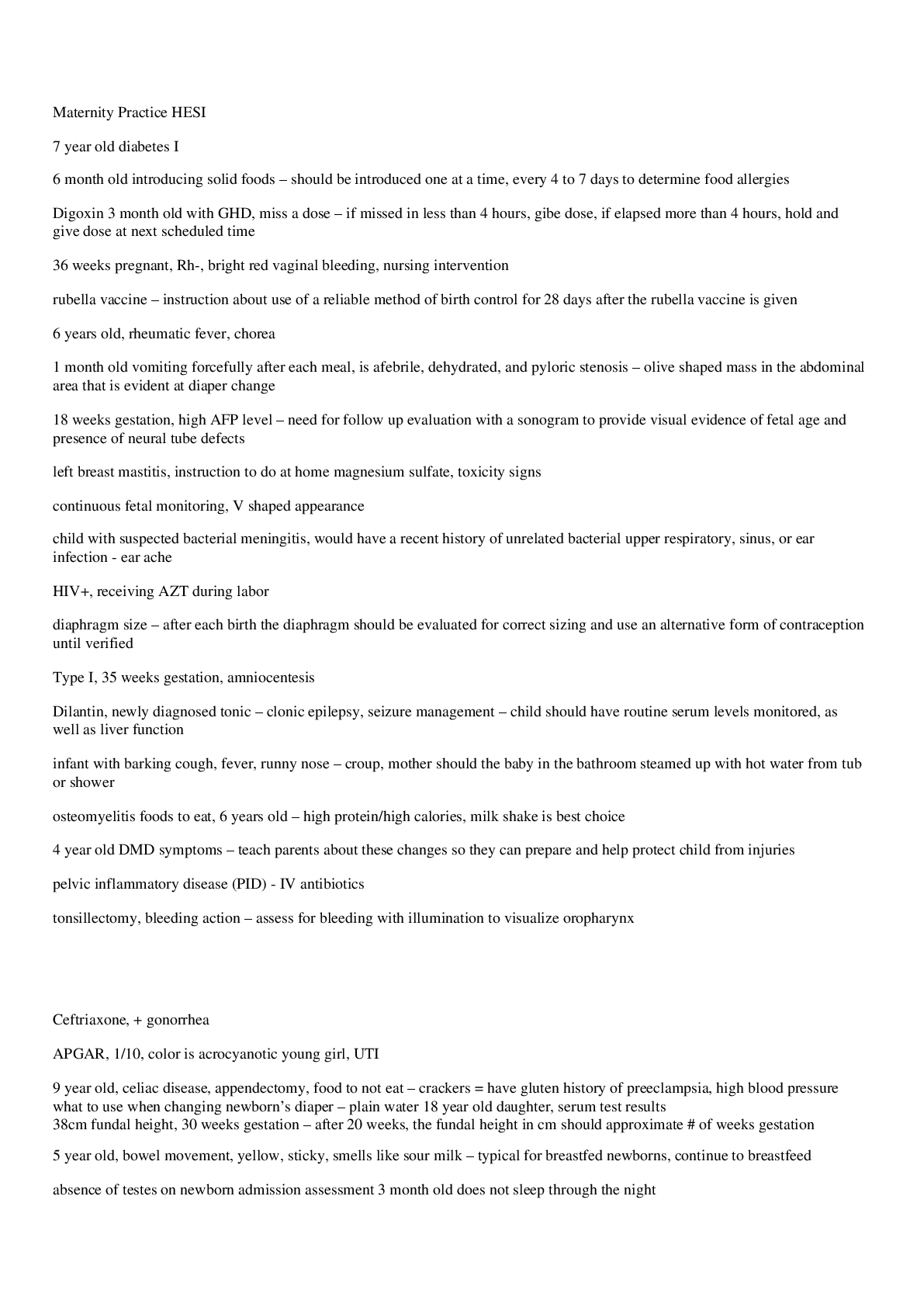

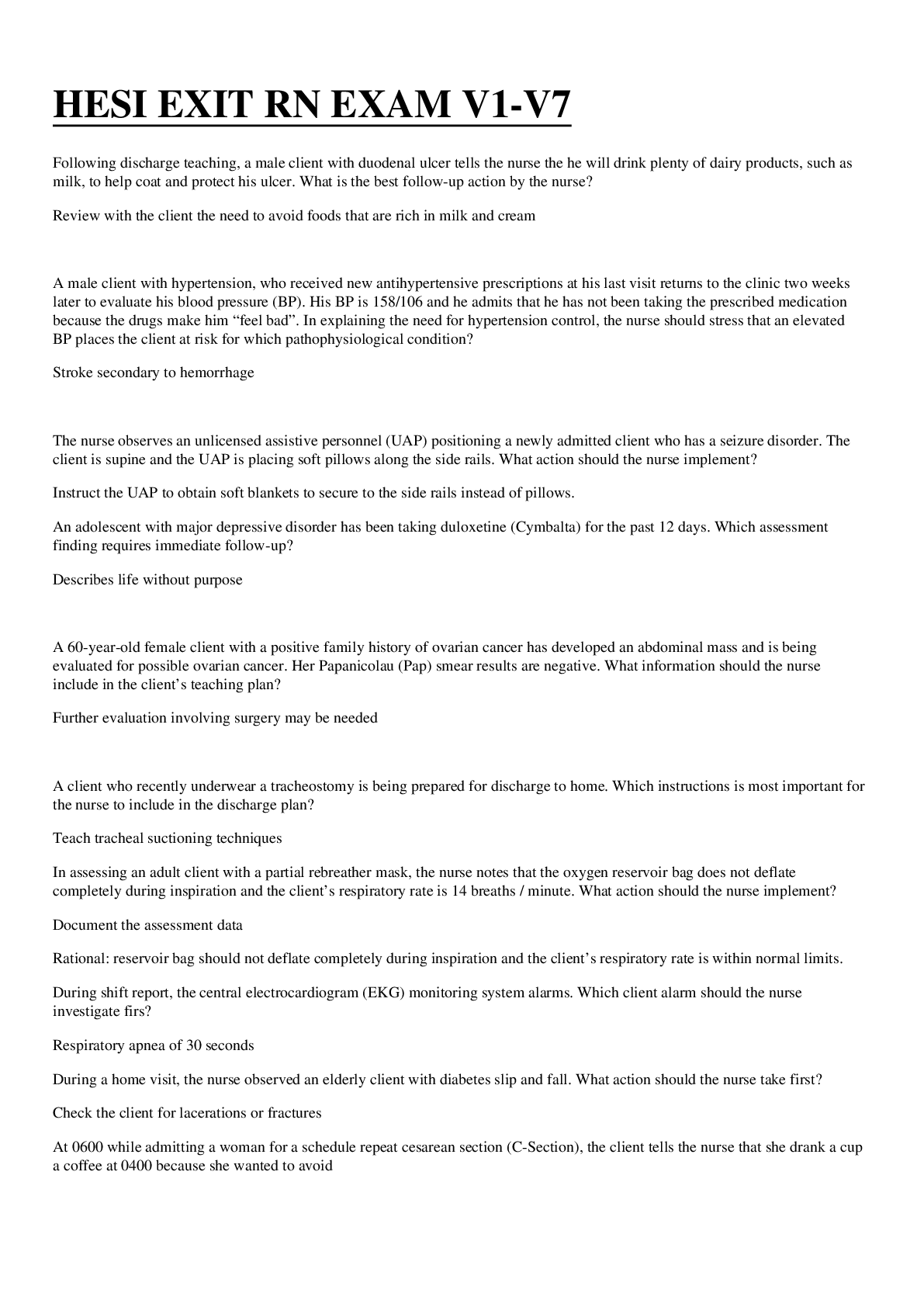



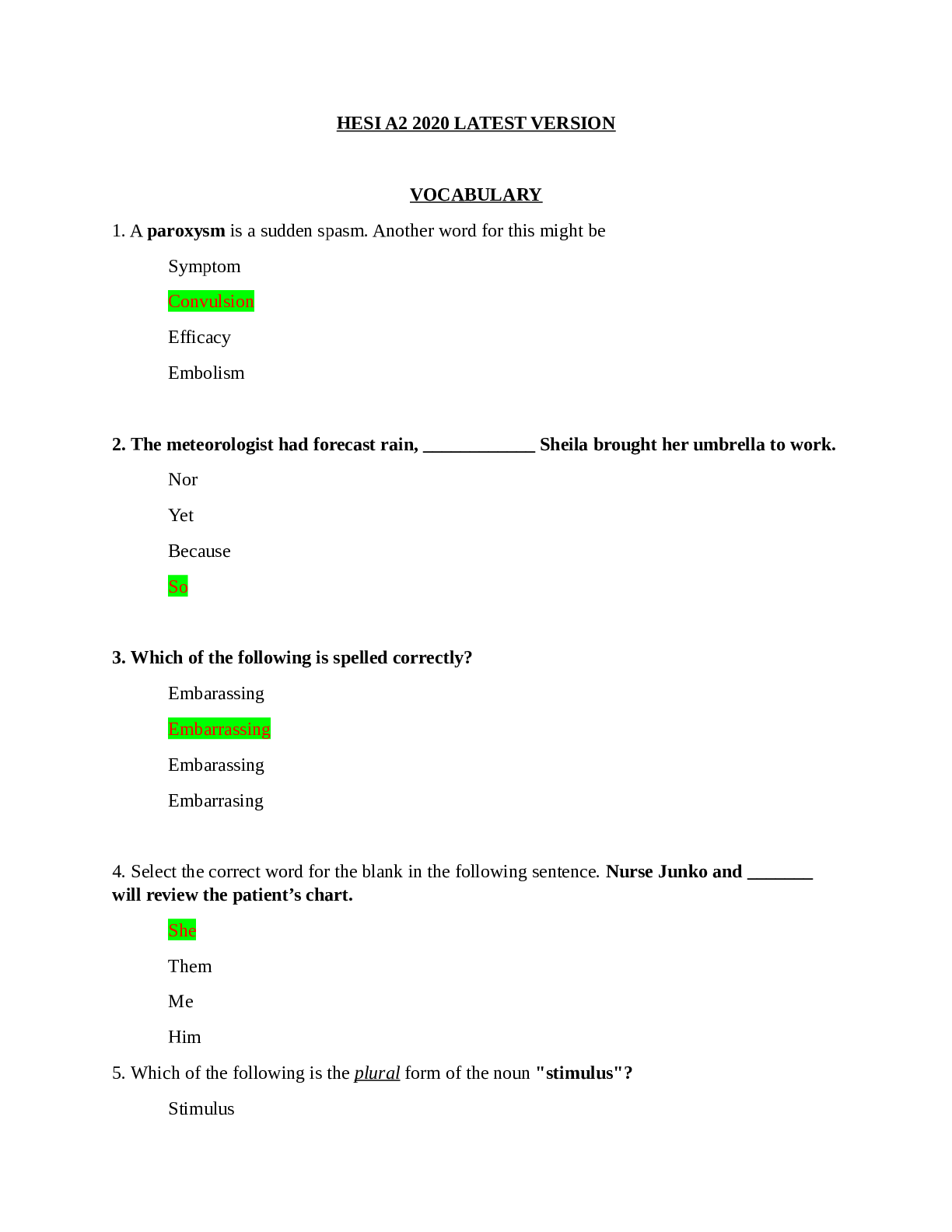



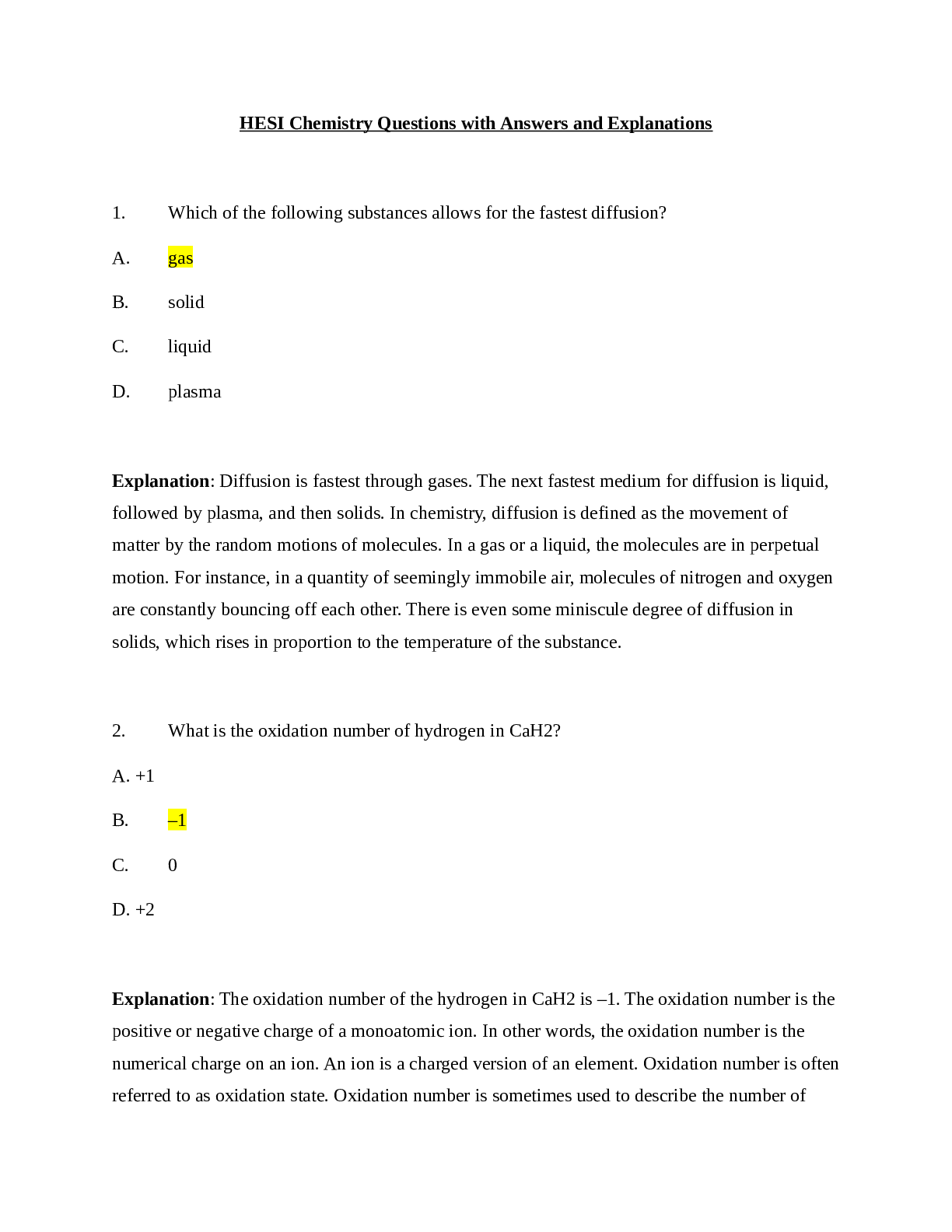
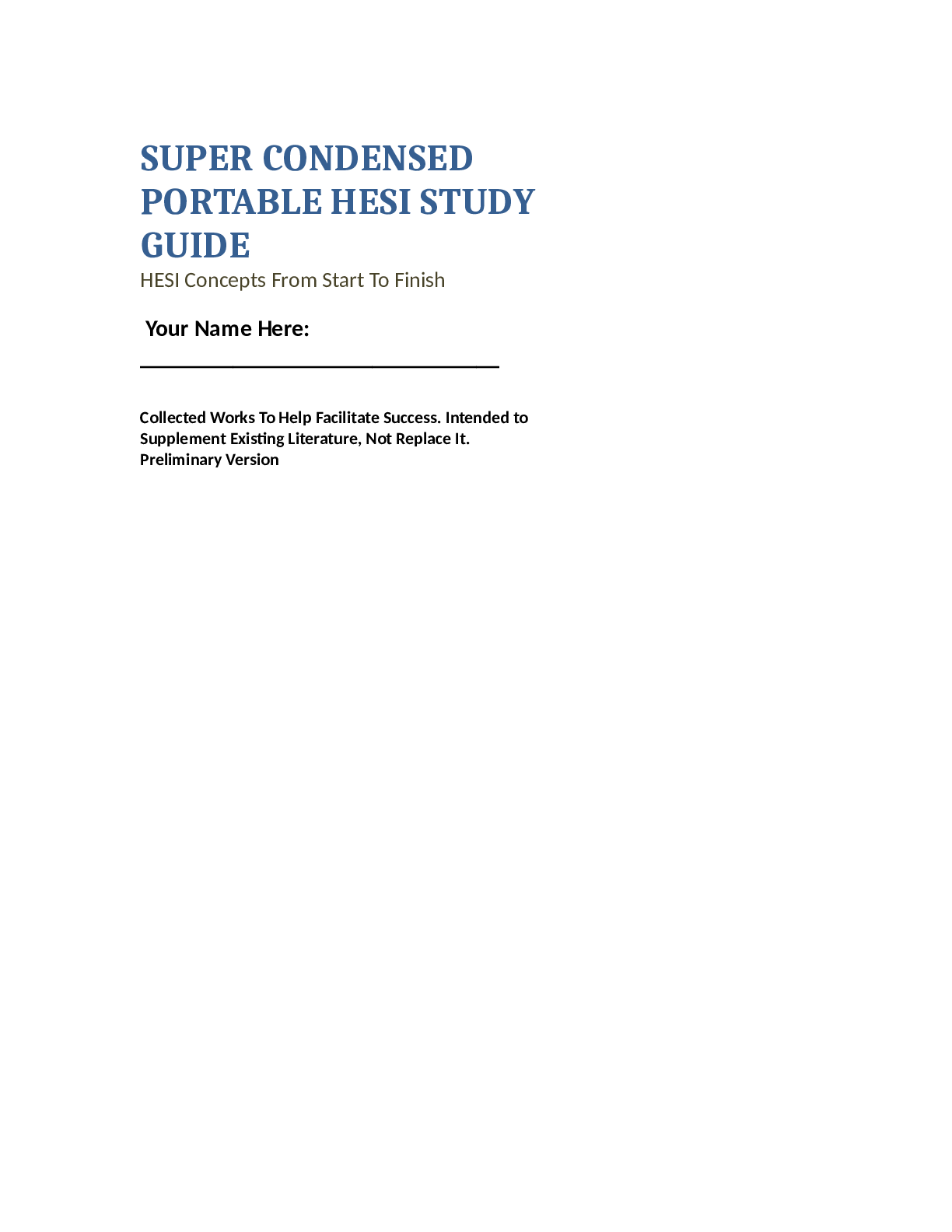




 (1).png)



